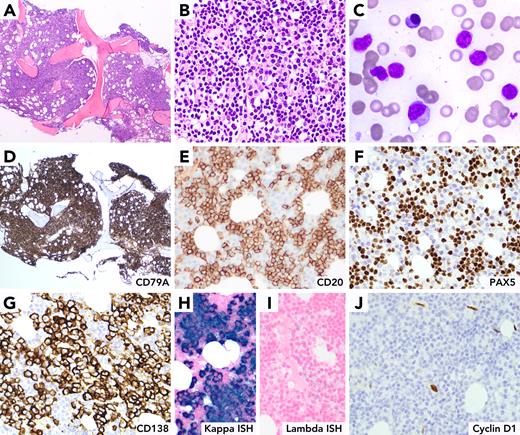A 67-year-old woman presented with anemia (hemoglobin, 8.1 g/dL) and neuropathy. Serum studies revealed immunoglobulin G (IgG) κ paraprotein (4.8 g/dL), significantly elevated IgG and free κ light chain (LC) levels (5.1 g/dL and 2.9 g/L), and increased κ/λ ratio (417.02). Urine studies confirmed κ Bence-Jones protein. Imaging revealed diffuse enhancing signals throughout bone without lymphadenopathy or lytic bone lesions. The bone marrow was hypercellular, diffusely replaced by interstitial small lymphocytes, plasmacytoid lymphocytes, and plasma cells (panels A-C, ×100/×500/×1000, original magnification). The infiltrate was diffusely positive for CD79a, consisting of CD20/PAX5+ B cells and many CD138/MUM1+ plasma cells with cytoplasmic κ LC restriction by in situ hybridization stains; cyclin D1 stain was negative (panel D, ×100; panels E-J, ×500, original magnification). Flow cytometric analysis showed κ-restricted monotypic B cells negative for CD5/CD10, and monotypic plasma cells positive for CD19 (partial)/CD45 (dim)/CD81, but negative for CD20/CD27/CD56/CD117. Routine myeloma fluorescence in situ hybridization analysis was negative. Next-generation sequencing identified mutations in MYD88 p.L265P and CXCR4 p.S339fs. A diagnosis of lymphoplasmacytic lymphoma (LPL) was rendered.
This case highlights the diagnostic challenge in non-IgM type LPL. The IgG monoclonal protein, extensive plasmacytic differentiation, and a high tumor burden are unusual features for LPL, mimicking plasma cell neoplasm clinically and morphologically.
For additional images, visit the ASH Image Bank, a reference and teaching tool that is continually updated with new atlas and case study images. For more information, visit http://imagebank.hematology.org.


This feature is available to Subscribers Only
Sign In or Create an Account Close Modal